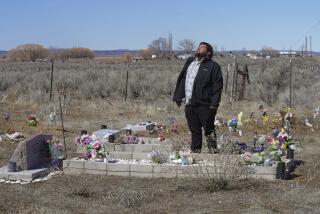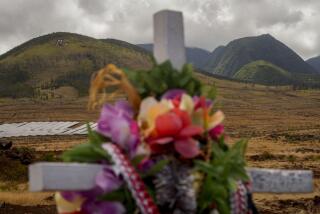Science / Medicine : Outsiders who sought to help this remote New Guinea tribe have become a threat to its survival. : Fatal Lure of Civilization
- Share via
In December, 1983, five young men from a virtually unknown tribe crossed the Yuat River in the highlands of Papua New Guinea and entered a Baptist mission.
Our people are dying out, the men told the missionaries. Our children do not thrive. We are deformed by disease. Our young men die in their prime. We don’t have enough women for our young men to have wives. We are willing to stop hiding in the jungle if we must. Please help us.
That fervent plea started a race to save the lives of the tribes people, now known as the Hagahai. Ironically, rather than improving their health through modern medicine, the Hagahai’s contact with civilization has exposed them to a whole new range of diseases, and in some ways their health has gotten worse.
The Hagahai’s emergence from hiding also triggered a second race--a race by anthropologists to document their culture and social life before it disappears. For by coming out of the jungle, the Hagahai exposed themselves to a broad cultural attack by neighboring tribesmen who covet their few women, by missionaries who covet their land and by outsiders who covet the gold and minerals believed to exist in the highlands.
And above all, the Hagahai fell under the seductive spell of a civilization that offers better clothes, better tools and other materialistic splendors. Civilization’s tug has already split the Hagahai into two competing camps, one that wants to live at the mission and one that wants to remain where they are and retain their old ways. Experts believe they may soon lose their cultural identity.
Already, Hagahai youth “hang around at the mission and disavow any knowledge of their culture,” said UC Davis anthropologist David Boyd.
“They are under a lot of pressure to change, so it’s urgent to get back in there and learn” before they do, said Boyd, who lived with them for four months last year and is returning this month for another six months. “It will be fascinating to watch how they are being integrated into our world, or how our world impinges on them . . . but I fear they are going to become spectacles, and that shouldn’t happen.”
The Baiyer River Valley in the Schrader Mountains of central Papua New Guinea is remote--four days walk from the nearest road--and governments are slow to react. The first Baptist missionary was stationed among the Hagahai in April, 1984, but the first government patrol did not reach them until July. That patrol was accompanied by Carol L. Jenkins, an American medical anthropologist on the staff of the Papua New Guinea Institute of Medical Research in Goroka.
What Jenkins found was distressing. Virtually all of the 289 Hagahai she eventually saw had recurrent malaria. Nearly 70% of them had enlarged spleens because of malaria, and one in three had the mammoth potbellies characteristic of a grossly enlarged spleen. Elephantiasis, diphtheria, filariasis and hookworm were endemic.
As many as 50% of the Hagahai were dying in their 30s, often from a breakdown of their immune systems, Jenkins said. By age 18, two-thirds of Hagahai youth had lost at least one parent. Most children never knew their grandparents.
Ironically, the Hagahai’s decision to seek medical help nearly proved medically disastrous. Since 1984, epidemics of mumps, hepatitis B and influenza A have swept through the population as a result of their contact with civilization, Jenkins said.
The influenza epidemic, for example, occurred in April, 1985, when four Hagahai men accompanied a missionary to his headquarters in the Western Highlands, contracted the disease and refused to wait for the symptoms to subside before returning home.
Between September, 1986, and June, 1987, Jenkins added, at least six deaths among adults and children resulted from an unidentified form of dysentery.
In the absence of help from the government, Jenkins and her colleagues have been soliciting funds and medications from around the world and have begun an intensive vaccination program. Unfortunately, no vaccine exists for malaria, the Hagahai’s most serious problem.
Overall, Jenkins said, the Hagahai’s birthrate is 33 per thousand, while their death rate is 44 per thousand. In the 12 months ending in September, 1987, nine of 13 infants born to the Hagahai died.
“We’re doing what we can with available medicine and vaccines,” Jenkins said. “We’ll make an attempt, but I don’t have a lot of hope. . . . Unless we have a lot of positive input . . . they’ll die out within 20 years.”
Early on, Jenkins recognized that the culture of the Hagahai needed to be documented and that she could not do it all herself. She took a straightforward route, placing an ad in an anthropology association newsletter:
Help Wanted, ethnologist. Remote location, miserable living conditions, long hours, must provide own salary . . . .
Enter Boyd, who earned his doctorate from UCLA studying the Awa tribe of Papua New Guinea and who already knew the institute’s director. “As soon as my wife pointed out the ad to me, I sent off a telegram asking how many people there were, what was known about them and so forth so I could write grant applications,” he said.
Boyd went to Papua New Guinea in August of last year and stayed until December, living at the mission and venturing into the field for one or two weeks at a time. During his stay, he lost nearly 20 pounds, developed recurring kidney stones from carrying too heavy a pack into the field and contracted malaria--from which he is only now recovering.
Boyd readily concedes that very little is yet known about the Hagahai--about their language, their religious rituals, their family relationships, how land is owned and transferred, and a host of other details. “It’s very frustrating to study them because they are so damn mobile,” he said. “Half the time when you go where you think they are, you find out that they are someplace else.”
But what he has learned so far is enough to tantalize him.
The Hagahai consist of five distinct tribes: Ginam, Luyaluya, Miyamiya, Mamusi and Pinale. The Pinale is the smallest group, with 16 members, and the Luyaluya is the largest with about 90. All speak dialects of the same language, which scientists now call Hagahai, although the people themselves seem to have no name for it.
But the word Hagahai is part of their language and that of neighboring people, Boyd said, and means roughly “Hey you!” or “What’s going on here!” “It’s not very satisfactory as a name,” Boyd said, “but it’s what we are stuck with.”
Jenkins and Boyd disagree on the basic nature of Hagahai society. Jenkins says they are a hunter-gatherer society that does a bit of gardening on the side. But Boyd argues that they are basically an agricultural society that supplements its diet by foraging in the forest.
But the Hagahai are not like most other agricultural societies because they don’t stay in one place.
Each group of six to 27 people--Boyd doesn’t know how members are selected or what their relationships are--may have eight to 10 garden plots scattered throughout the jungle. These are not simple gardens scratched out of the wilderness, but large plots up to 2 1/2 acres in size enclosed by massive wooden fences designed to keep out wild pigs and other animals.
Some of the garden plots have thatched houses nearby that resemble permanent residences, but others have only smaller structures more like lean-tos, Boyd said. These residences give them places to stay while they move around the forest and exploit wild resources. “But they are not nomadic, they seem to have very structured rounds,” Boyd said.
Life among the Hagahai is simple, he said. They sleep on the ground inside their huts. They rise at sunup, which occurs at nearly the same time throughout the year because they live only 6 degrees south of the Equator. After they get up, they sit around the fire warming themselves and begin smoking and chewing. “Everybody smokes tobacco, including women and children,” Boyd said, “and they chew betel nut nonstop.”
“There’s no urgency attached to any particular kind of task that needs to be done,” Boyd said. “If something comes up, they change their plans.” A group working in a garden, for example, may see smoke from a fire in the distance and go off to see what some other person has captured--and, of course, to share in the meal.
Surprisingly, Boyd said, there are clear limits to who can exploit what resources, and the Hagahai are very respectful of those limits. Boyd recalls traveling with two men to visit an older man who lived in a remote location. No one was home when they got there, so they decided to wait. The man did not return until the next day, Boyd said, and his companions refused to pick anything from the man’s trees or garden, “so we didn’t eat for 24 hours.”
Beyond disease, the biggest immediate problem facing the Hagahai is the shortage of marriageable women. In December, the ratio of males to females was 150/100, and under the age of 15, the ratio was 175/100. “We simply don’t know why,” Boyd said. “There is obvious potential for infanticide, but no direct evidence for it. “
When Boyd left Papua New Guinea last December, there were only five women over the age of 15 who had never been married. One of them has since married, and two are unlikely to marry because they are already in their late 20s and their family has consistently refused offers, Boyd said. In contrast, there were 43 men over the age of 15 who had never been married.
The Hagahai, furthermore, are one of the few tribes in the region in which the groom does not have to make payment to the bride’s family. Poor men from other tribes may thus come in and seek wives among them, he said. “If these ‘irresistible young men’ come in with their shoes, sunglasses, transistor radios and so forth,” further depleting the tribe’s female population, “then they (the Hagahai) are really going to be in trouble.”
More to Read
Sign up for Essential California
The most important California stories and recommendations in your inbox every morning.
You may occasionally receive promotional content from the Los Angeles Times.










